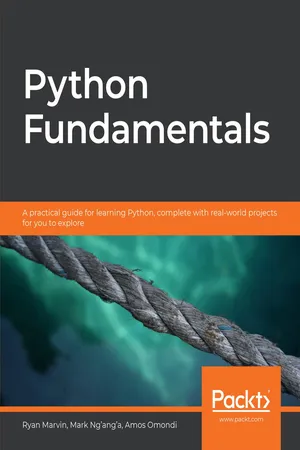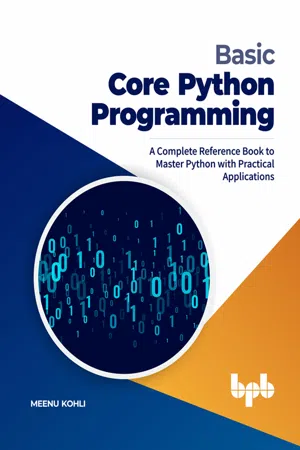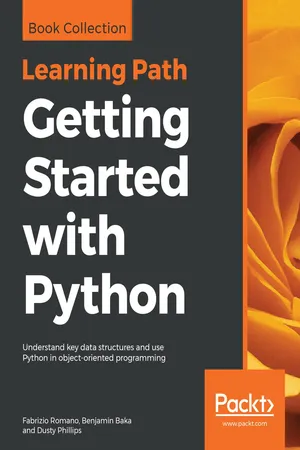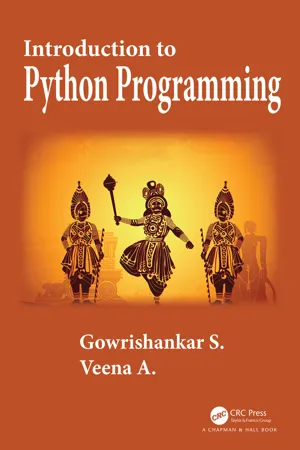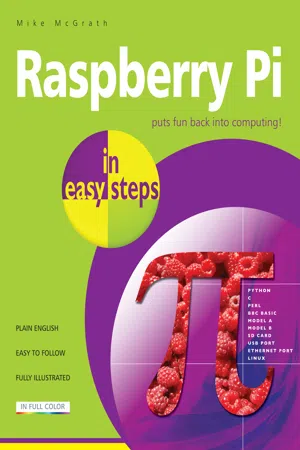Computer Science
Python while else
In Python, the "while else" statement is used to execute a block of code within the "else" clause after the while loop has completed its iterations. If the while loop terminates normally (i.e., without encountering a "break" statement), the code within the "else" block is executed. This can be useful for performing additional actions after the completion of a while loop.
Written by Perlego with AI-assistance
Related key terms
Related key terms
1 of 4
Related key terms
1 of 3
6 Key excerpts on "Python while else"
- eBook - ePub
Python Fundamentals
A practical guide for learning Python, complete with real-world projects for you to explore
- Ryan Marvin, Mark Ng'ang'a, Amos Omondi(Authors)
- 2018(Publication Date)
- Packt Publishing(Publisher)
if_python.py and add your code to it. Then, run it in a terminal. The output should be as follows:>python if_python.py Return TRUE or FALSE: Python was released in 1991: TRUE Correct Bye! >python if_python.py Return TRUE or FALSE: Python was released in 1991: FALSE Wrong Bye!Note
Solution for this activity can be found at page 283.The while Statement
A while statement allows you to execute a block of code repeatedly, as long as a condition remains true. That is to say, as long as condition X remains true, execute this code .A while statement can also have an else clause that will be executed exactly once when the condition, X , that's mentioned is no longer true. This can be read as follows: As long as X remains true, execute this block of code, else, execute this other block of code immediately so that the condition is no longer true .For instance, consider the traffic police officer we mentioned earlier, who could be letting traffic through while the exit is clear, and as soon as it is not clear, they stop the drivers from exiting.Here is the basic syntax of a while statement:while condition: # Run this code while condition is true # Replace the "condition" above with an actual condition # This code keeps running as long as the condition evaluates to True else: # Run the code in here once the condition is no longer true # This code only runs one time unlike the code in the while blockAs mentioned earlier, this can be read as: As long as the condition is true, execute the first block of code, and if the condition is not true, execute the second block of code .Exercise 15: Using the while Statement
Now we will look at a practical use of the while statement:- First, declare a variable called current and set its value to 1 :current = 1
- Declare the end variable and set its value to 10 :end = 10
- Then, write a while statement.The condition of this while statement is that the current
- eBook - ePub
Basic Core Python Programming
A Complete Reference Book to Master Python with Practical Applications (English Edition)
- Meenu Kohli(Author)
- 2021(Publication Date)
- BPB Publications(Publisher)
HAPTER 8Program Flow Control in Python
Introduction
So far, you have seen simple statements in coding. The examples of code that we have tried so far in this book have executed line-by-line very smoothly without any issues. But in the real world of software development, you will be working on complex logic. In this chapter, you will learn about the statements used for decision making and controlling the program flow. These statements control the execution of code. So, get ready to work with control structures.Structure
- Working with ‘if’
- if .. elif..else
- if statement
- if..else statement
- Nested if statement
- For loops
- Iterating over a range of numbers
- Convert a range into a list
- Negative steps in range
- Iterating over a range of numbers
- while loops
- else clause with loops
- continue, break and pass statements
- Recap on control structures
- Python iterators
- Python generators
Objective
After reading this chapter, you will be able to:- Work with ‘if’ statements
- Work with for loops
- Work with while loops
- Use else clause with loops
- Work with continue, break, and pass statements
- Work with Python iterators
- Work with Python generators
There is a block of code associated with every control flow statement. This block of code is defined by a colon (‘:’) and indentation. You are aware that Python uses four spaces (PEP-8 standard) of indentation to mark the beginning of a block of code. Usage of a tab instead of four spaces is not recommended as per the best practices defined in PEP-8. In all languages, indentation is required only to improve the readability and the block of code is defined in a curly brace ({}). However, in Python programming indentation is crucial.8.1 Working with ‘if’
While programming you will often come to a point where you will have to decide how your program will work under different scenarios. For example, you build campus management software for your school but you cannot give the same privileges to all the users. You will have different privileges for students and teachers. So, if a student logs in then there are one set of privileges available and if the teacher logs in then another set of privileges are available. - eBook - ePub
- Stef Maruch, Aahz Maruch(Authors)
- 2011(Publication Date)
- For Dummies(Publisher)
break statement in it. It works like this:1.Each time around the loop, the condition in the if statement is tested.2.If the condition is true, the break statement causes everything else in the loop (including the else block) to be skipped. Control exits the loop.3.If the condition is false, the loop starts over again.4.If the loop iterator runs out before the if condition evaluates as true, the for loop’s else clause gets executed.The following code determines whether a string (in this case, “larch” ) contains any lowercase vowels:mystring = “larch” vowels = set(‘aeiou’) for a in mystring: if a in vowels: print mystring, “has a vowel” break else: print mystring, “does not have a vowel” The result is: larch has a vowelLet’s continue
When Python sees a continue statement in the middle of a loop code block, it skips the rest of the code in the block and goes back to the top of the loop. Here’s how it works. This code block prints both “5” and “five” because the print n, statement is executed each time through the loop.>>> for n in range(10): ... if n == 5: ... print “five”, ... print n, ... 0 1 2 3 4 five 5 6 7 8 9When we add continue to the if block, Python skips the last print n, statement when the loop condition evaluates as true; therefore, it prints only “five”:>>> for n in range(10): ... if n == 5: ... print “five”, ... continue ... print n, ... 0 1 2 3 4 five 6 7 8 9Use continue statements sparingly because they can make your code hard to read, especially if they are nested in complex structures.Thanks, but I’ll pass
The pass keyword tells the Python interpreter to do nothing. It is usually used in class statements, but you’ll also find it useful in while or for loops when the program requires no action. In this example, the argument_clinic() function does nothing if its argument is greater than or equal to 5:>>> def argument_clinic(minutes): ... if minutes >= 5: ... pass ... else: ... print “No it isn’t!” - eBook - ePub
Getting Started with Python
Understand key data structures and use Python in object-oriented programming
- Fabrizio Romano, Benjamin Baka, Dusty Phillips(Authors)
- 2019(Publication Date)
- Packt Publishing(Publisher)
Iterating and Making Decisions
"Insanity: doing the same thing over and over again and expecting different results." – Albert Einstein In the previous chapter, we looked at Python's built-in data types. Now that you're familiar with data in its many forms and shapes, it's time to start looking at how a program can use it. According to Wikipedia:In computer science, control flow (or alternatively, flow of control) refers to the specification of the order in which the individual statements, instructions or function calls of an imperative program are executed or evaluated.In order to control the flow of a program, we have two main weapons: conditional programming (also known as branching ) and looping . We can use them in many different combinations and variations, but in this chapter, instead of going through all the possible forms of those two constructs in a documentation fashion, I'd rather give you the basics and then I'll write a couple of small scripts with you. In the first one, we'll see how to create a rudimentary prime-number generator, while in the second one, we'll see how to apply discounts to customers based on coupons. This way, you should get a better feeling for how conditional programming and looping can be used.In this chapter, we are going to cover the following:- Conditional programming
- Looping in Python
- A quick peek at the itertools module
Passage contains an image
Conditional programming
Conditional programming, or branching, is something you do every day, every moment. It's about evaluating conditions: if the light is green, then I can cross; if it's raining, then I'm taking the umbrella; and if I'm late for work, then I'll call my manager .The main tool is the if statement, which comes in different forms and colors, but basically it evaluates an expression and, based on the result, chooses which part of the code to execute. As usual, let's look at an example: - eBook - ePub
- Gowrishankar S, Veena A(Authors)
- 2018(Publication Date)
- Chapman and Hall/CRC(Publisher)
3 Control Flow StatementsAIM Understand if, if…else and if…elif…else statements and use of control flow statements that provide a means for looping over a section of code multiple times within the program. LEARNING OUTCOMES At the end of this chapter, you are expected to • Use if, if…else and if…elif…else statements to transfer the control from one part of the program to another. • Write while and for loops to run one or more statements repeatedly.• Control the flow of execution using break and continue statements.• Improve the reliability of code by incorporating exception handling mechanisms through try-except blocks.Python supports a set of control flow statements that you can integrate into your program. The statements inside your Python program are generally executed sequentially from top to bottom, in the order that they appear. Apart from sequential control flow statements you can employ decision making and looping control flow statements to break up the flow of execution thus enabling your program to conditionally execute particular blocks of code. The term control flow details the direction the program takes.The control flow statements (FIGURE 3.1 ) in Python Programming Language are1. Sequential Control Flow Statements: This refers to the line by line execution, in which the statements are executed sequentially, in the same order in which they appear in the program.2. Decision Control Flow Statements: Depending on whether a condition is True or False, the decision structure may skip the execution of an entire block of statements or even execute one block of statements instead of other (if, if…else and if…elif…else).3. Loop Control Flow Statements: This is a control structure that allows the execution of a block of statements multiple times until a loop termination condition is met (for loop and while - eBook - ePub
- Mike McGrath(Author)
- 2013(Publication Date)
- In Easy Steps Limited(Publisher)
Launch a plain text editor and begin a new Python program by locating the interpreter#! /usr/bin/env python PYRequest the user enter a number to initialize a variablenum = input( ‘Please Enter A Number: ‘ )Next, test the variable and display an appropriate responseif num > 5 : print( ‘Number exceeds 5’ ) elif num < 5 : print( ‘Number Is Less Than 5’ )print( ‘Number Is 5’ )else :Now, test the variable again using two expressions and display an appropriate response only upon successif num > 7 and num < 9 : print( ‘Number Is 8’ ) if num == 1 or num == 3 : print( ‘Number Is 1 Or 3’ )Save the file and make it executable withchmodthen run the program and enter a number to see the responsesTheandkeyword ensures the evaluation isTrueonly when both tests succeed, whereas theorkeyword ensures the evaluation isTruewhen either test succeeds.Looping while trueA loop is a piece of code in a program that automatically repeats. One complete execution of all statements within a loop is called an “iteration” or “pass”. The length of the loop is controlled by a conditional test made within the loop. While the tested expression is found to beTruethe loop will continue – until the tested expression is found to beFalse, at which point the loop ends.Unlike other Python keywords the keywordsTrueandFalsebegin with uppercase letters.In Python programming, thewhilekeyword creates a loop.It is followed by the test expression, then a : colon character. Statements to be executed when the test succeeds should follow below on separate lines and each line must be indented the same space from theIndentation of code blocks must also be observed in Python’s interactive mode – like this example that produces a Fibonacci sequence of numbers from a while loop:whiletest line. This statement block must include a statement that will at some point change the result of the test expression evaluation – otherwise an infinite loop is created.The interpreter provides a ... continuation prompt when it expects further statements. Hit Tab to indent each statement then hit Return to continue. Hit Return directly at the continuation prompt to discontinue.
Index pages curate the most relevant extracts from our library of academic textbooks. They’ve been created using an in-house natural language model (NLM), each adding context and meaning to key research topics.
Explore more topic indexes
Explore more topic indexes
1 of 6
Explore more topic indexes
1 of 4
